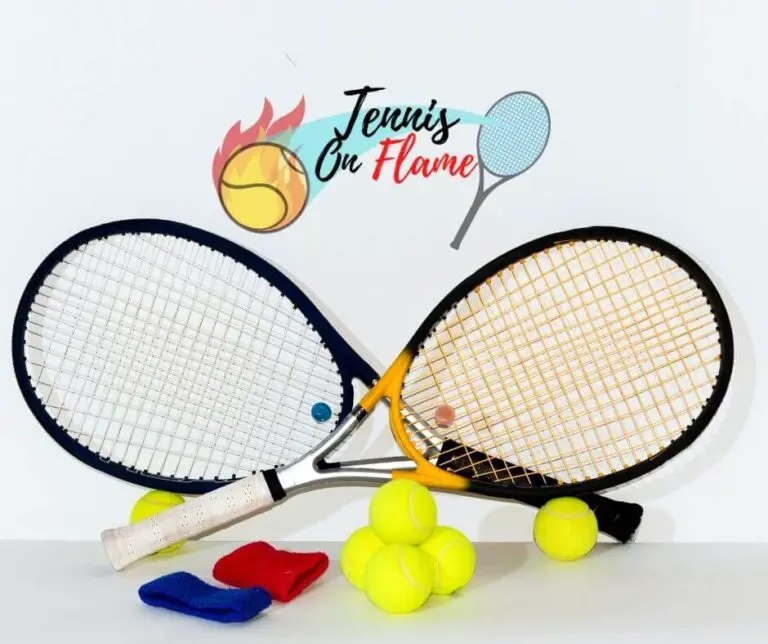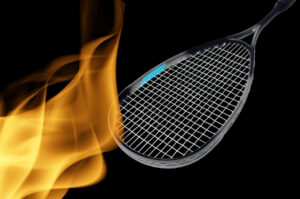Why tennis players change rackets is a really good question with a very simple answer:
There are many reasons why tennis players might change rackets.
Some might feel that their current racket isn’t giving them the power or control they need, while others may find that their current racket is causing arm pain.
New materials, new technologies, and even new shapes allow players to get more power out of every swing while simultaneously getting an easier spin on their serves and groundstrokes.
In this blog post, we will explore some of the most common reasons why tennis players might choose to switch rackets.
We will also discuss the benefits of doing so and provide advice on how to select the right racket for your game.

How often do tennis players change rackets?
Rackets last around a year and lose stiffness after that for professional players, who train on a regular basis and participate in events.
Because of that many professional players change rackets every few months, while others may use the same racket for an entire year.
At least two years, a new racquet should last if you are a club player who plays twice a week.
A club player who takes good care of their rackets and does not hit the ball particularly hard might have rackets that endure for ten years or more without issue.
After we find out How often tennis players change rackets, let’s see what are they doing with their old tennis rackets...
What do tennis players do with their old rackets?
Players often sell their old rackets for extra money.
They do not typically keep them because their game has evolved.
However, some players will keep old rackets around to practice with or for sentimental reasons.
Some players will donate their rackets to charity.
Why do tennis players have multiple rackets?
It is important for tennis players to have multiple rackets because they are constantly changing types of strings, during their game.
Different strings will also change how a racket plays. This requires players to adapt their game.
A change in strings can also make a racket more powerful or easier to handle.
Strings that are looser will provide a player more power, while strings that are tighter will grant a player greater control.
If their game evolves, they will need to adapt their equipment to match it.
Players may string their rackets with various tensions according to their plan.
Are new tennis racquets better?
New tennis racket technologies can provide players with a number of benefits.
These include more power, better control, and easier spin on serves and groundstrokes.
Many of these new technologies come in the form of improved materials and construction methods.
Racquets have grown in size, weight, stiffness, and openness of string patterns and thicker beams.
Players who want to stay at the top of their game must adopt these better rackets for their game to continue to improve.
What are the four categories of tennis racquets?
There are four different categories of tennis rackets that are made for different styles of play: the Power racket, the Control or Player’s racket, the Tweener racket, and the Modern Player’s racket.
The Power racket is made for players who hit the ball hard with a lot of spins. These rackets are typically lighter and have larger sweet spots.
The Control or Player’s racket is made for players who want more control over their shots. These rackets are typically heavier and have smaller sweet spots.
The Tweener racket is made for beginner and intermediate players. These rackets are typically a happy medium between the power and control rackets.
The Modern Player’s racket is made for players who want all the latest technology and benefits that come with it. These rackets are typically the most expensive and have the latest advancements.
for more information Check out my best tennis rackets by skill level or by benefit.
What is the best tennis racquet?
There is no “best” tennis racket. In fact, there’s a whole range of different types of rackets that are suited to different styles of play.
What’s right for one player may not be the best choice for someone else.
The trick is to understand what type of game you have, and then match your racquet selection with your style of play.
Are tennis rackets easy to break?
Tennis rackets are not easy to break. In fact, they’re designed to withstand a lot of wear and tear.
The beam that connects the head to the handle is the racket’s most vulnerable region, and it is frequently the first to break.
If you play with a lot of power and spin, you may eventually break the head of your racket. However, this is not common.
Tennis rackets are designed to last for many years, with regular use.
What is the best type of string for tennis?
The best type of string for tennis is the one that suits your playing style and level the best.
If you are a beginner or intermediate player, natural gut or nylon strings are the best choices for you.
These strings provide power and comfort properties that are perfect for players who are still developing their skills.
If you are an advanced player, polyester strings are the best choice for you.
These strings provide stiffer, control-oriented properties that are perfect for players who have mastered their skills and are looking to take their game to the next level.
Finally, let’s find out why tennis players change grips during a match…
Why do tennis players change grips during a match? –
Players change grips during a match to stay comfortable and to maintain their grip on the racket.
When players sweat, their grip can become slippery and uncomfortable to hold.
By changing the grip, the player can feel more comfortable and maintain a better grip on the racket.
In conclusion:
Tennis players change rackets for a variety of reasons, but the most common reason is that they are simply not satisfied with their current racket.
Perhaps it doesn’t provide the right level of power or control, or maybe it doesn’t feel quite comfortable in their hand.
In any case, tennis players are always looking for ways to improve their game, and changing rackets is often seen as one of the easiest and most effective ways to do so.
Of course, there is no guarantee that a new racket will instantly transform a player’s game, but it is certainly worth a try for those who are unhappy with their current setup.
I hope you enjoyed this article.
If you have any questions or comments, please feel free to leave them below.
Thanks for reading! 🙂








